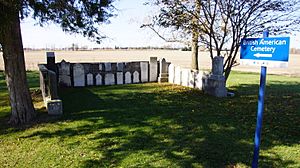Uncle Tom's Cabin Historic Site facts for kids
| Site historique de la Case de l'oncle Tom | |
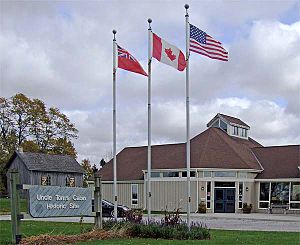
Visitor centre for Uncle Tom's Historic Site
|
|
| Established | 1964 |
|---|---|
| Location | 29251 Uncle Toms Road, Dresden, Ontario, Canada |
| Type | Open air museum |
| Owner | Ontario Heritage Trust |
| Official name: Uncle Tom's Cabin Historic Site | |
| Designated: | 6 April 2005 |
The Uncle Tom's Cabin Historic Site is a special museum in Dresden, Canada. It's an open-air museum, meaning it has buildings and outdoor areas you can explore. This site teaches us about the amazing life of Josiah Henson. He was a former slave, a minister, and a brave leader who helped many people find freedom.
The museum also shares the important history of slavery and the Underground Railroad. This was a secret network that helped enslaved people escape to freedom. The site is built on the land where Josiah Henson started a community called the Dawn settlement. Josiah Henson's own story inspired the main character in the famous book Uncle Tom's Cabin by Harriet Beecher Stowe.
This historic site covers about 5 acres of land. It includes a visitor center, old buildings from the Dawn settlement, and two cemeteries. One of these cemeteries is where Josiah Henson is buried. People started visiting Henson's family home in 1948. The larger museum officially opened in 1964. It has been cared for by different groups over the years, and since 2005, the Ontario Heritage Trust has managed it.
Contents
Exploring the History of Dawn Settlement
This section tells you how the Dawn settlement began. It was a safe place for people seeking freedom.
Who Was Josiah Henson?
The historic site started because of Josiah Henson. He was a Methodist preacher who had been enslaved. He bravely escaped to Canada on October 28, 1830. Even after finding his own freedom, Henson returned to the United States many times. He helped other enslaved people escape to Canada through the Underground Railroad. It's believed that Henson personally guided 118 people to freedom. He also led a Black Canadian Militia unit during the Rebellions of 1837–38.
Starting the Dawn Community
The Dawn settlement was created in 1841. Henson bought a large piece of land, about 200 acres. This land was meant to be a safe haven and a place for former slaves from the United States to work. The settlement grew crops and harvested eastern black walnut wood. This wood was sold to places like the United Kingdom and the United States.
In 1842, Henson helped start the British-American Institute in Dawn. This school taught settlers useful skills for jobs. A sawmill was also built in the settlement. The products from this sawmill even won Henson a medal at the Great Exhibition in London!
How Josiah Henson Inspired a Famous Book
In 1849, Josiah Henson wrote a book about his life. It was called The Life of Josiah Henson, Formerly a Slave, Now an Inhabitant of Canada, as Narrated by Himself. This book caught the attention of people who wanted to end slavery. His story later inspired the main character, Uncle Tom, in Harriet Beecher Stowe's famous anti-slavery novel, Uncle Tom's Cabin.
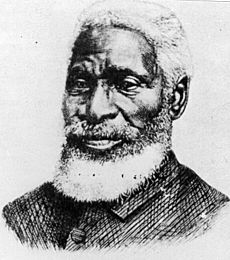
When Uncle Tom's Cabin was first published, some people in the United States who supported slavery said the book was not true. Harriet Beecher Stowe responded by writing another book, A Key to Uncle Tom's Cabin. In this second book, she explained that she got her ideas for Uncle Tom from Josiah Henson's published life story.
The Decline of the Settlement
At its busiest, about 500 people lived in the Dawn settlement. However, after the Emancipation Proclamation in 1862, many settlers started to return to the United States. During the American Civil War, Henson supported families whose male members went back to fight. The settlement slowly declined after the British-American Institute closed in 1868. The remaining settlers moved to other communities in Ontario.
Josiah Henson stayed at the settlement until he passed away in 1883. He was buried near his home. His funeral was one of the largest ever held in Dresden. Businesses closed for the day, and a 2-kilometer procession followed his coffin. After Henson's death, his wife sold their home and moved away.
Creating the Historic Site
After Henson's wife sold the house, it was left empty for a while. In the 1920s, the house became a special place for Black Freemasons to visit. Josiah Henson had joined the Freemasons later in his life.
Caring for the Gravesites
In 1930, members of the Imperial Order Daughters of the Empire (IODE) started looking after the gravesites on the property. The Dresden & District Horticultural Society joined them the next year. By May 1933, the horticultural society was officially in charge of maintaining the gravesites.
Opening to the Public
William Chapple, who owned the land around Henson's home, saw it as a possible tourist spot. He opened the house to the public in 1948. Chapple even wrote a book, The Story of Uncle Tom, to help promote the building. Visitors would leave donations in a pot outside the house.
Later, Chapple sold the property to Jack Tomson. Tomson moved Henson's home twice to new spots on the property. In 1964, Tomson opened the entire property as a museum. He hired Barbara Carter, a descendant of Henson, to be the museum's curator. Under Carter's leadership, the museum started to focus not just on Henson's life, but also on the wider history of slavery and the Underground Railroad.
Restoration and Recognition
In 1984, Kent County bought the property and ran the museum. In 1995, ownership was transferred to the St. Clair Parkway Commission. That same year, a big restoration project costing C$1.2 million took place. The buildings were restored to how they looked in the past, and a new visitor center was built.
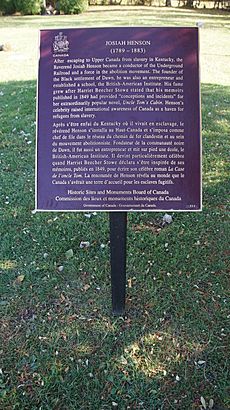
In 1999, the Historic Sites and Monuments Board of Canada placed a special plaque near Henson's grave. This plaque recognized him as a "Canadian of National Historic Significance." In 2005, the property was transferred again to the Ontario Heritage Trust. This is an agency of Ontario's government that protects heritage sites. That same year, three historic buildings on the property were officially recognized as heritage buildings under the Ontario Heritage Act.
Exploring the Museum Grounds
The historic site is located in southwest Dresden, near the Sydenham River. It's an open-air museum on 5 acres of land. This land was once part of the Dawn settlement's British-American Institute.
Visitor Centre and Exhibits
The property has a modern interpretive visitor center, built in 1994. Inside, you'll find the North Star Theatre, the Underground Railroad Freedom Gallery, and a gift shop. The theatre usually shows a video about Josiah Henson's life. The gallery displays artifacts related to the Dawn settlement, Henson's life, and the Underground Railroad. The museum's collection even includes an early copy of Henson's autobiography.
Cemeteries and Memorials
There are two cemeteries at the historic site. One is for the British-American Institute, and the other is the Henson family cemetery. Only 21 gravestones are visible at the Henson family cemetery, but it's believed that over 300 graves are located there. A special monument honoring Henson is placed near his grave. It has a Masonic symbol and a crown, which represents his visit with Queen Victoria.
Other Historic Structures
Besides the visitor center and gravesites, the property also has several other historic buildings. These include a sawmill and a smokehouse. Three of these buildings are officially recognized under the Ontario Heritage Act.
Historic Buildings to Explore
There are three historic buildings at Uncle Tom's Historic Site that are recognized under the Ontario Heritage Act. All of them date back to the 19th century. Two of these homes belonged to people who lived in the Dawn settlement. The Pioneer Church is an old church that was moved to the site.
The Henson Family Home
The Henson family home is a good example of a typical 19th-century house. It's a two-story building made of wood, with a frame of posts and beams. It was built using local materials like red oak. The building has been moved several times, but always stayed within the original Dawn settlement area. The exact age of the Henson home is hard to pinpoint, but it's thought to have been built around 1850.
In 1995, the house was restored to look like it did in the 1850s. A fireplace that wasn't part of the original design was removed. The original front porch was rebuilt on the south side of the home. During this restoration, the inner beams were made stronger, and the outer wooden boards were replaced.
The Harris House
The Harris House is another historic two-story wooden building on the property. It was built in 1890 and originally stood in another part of Dresden. After its first owners left, it was used as a storage building for grain on a nearby farm. In 1964, it was moved to Uncle Tom's Cabin Historic Site to help with museum operations. This house shows a common style of building used by Black refugees arriving in Canada during that time. It's about 5 meters by 5 meters and was built with local materials. It doesn't have fancy decorations and only has two rooms. One room on the first floor was for daily activities, and the second floor was for sleeping. The Harris House was also designed to keep people warm in winter. It was built taller than usual to help the heat from the fireplace rise and warm the whole house.
The Pioneer Church
The third historic building on the property is the Pioneer Church. It's a one-room, single-story wooden building with a pointed roof, designed in a Carpenter Gothic style. This style was common for churches in rural Ontario during that period. Even though the Pioneer Church dates back to the 1850s, it wasn't built by the people of the Dawn settlement. It was originally located about 70 kilometers away in Wheatley, Ontario. It served as both an Anglican and Presbyterian church.
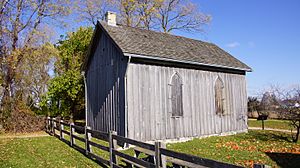
The Pioneer Church was moved to the Uncle Tom's Historic Site in the 1960s. It was chosen because it looked very similar to the original church built in the Dawn settlement in its design, materials, and size. The original Dawn church was used for many things besides church services, but it was destroyed in a fire in the early 1900s. However, two items from the original church were saved and placed in the Pioneer Church: the oak pulpit and the organ.
Museum Connections
The Uncle Tom's Cabin Historic Site works with several other educational and museum groups in Canada. These include the Canadian Museums Association, the Canadian Heritage Information Network, and the Virtual Museum of Canada.
|


